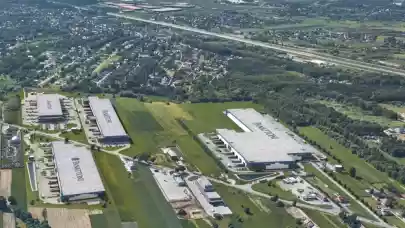
In March-April 2023, the Ukrainian Real Estate Club conducted a survey of almost 100 representatives of Ukrainian companies that continue to operate in the market and do business during the war. Of course, all market participants, regardless of their region of operation, felt the negative economic consequences. Despite this, the market is rather optimistic and proactive, as evidenced by the survey results, Olga Solovei (URE Club) reports for Property Forum.
Among the companies that took part in the survey are development and construction companies, real estate project management companies, and architectural and service companies.
Results of 2022
What happened to the main asset - the staff of real estate companies? We tried to study the management response to the number of employees and the format of their work. At the end of the year, it became clear that the first reaction and a significant reduction in the number of employees or payments will be a critical factor in the recovery.
Only 35% of companies did not change the number of employees in 2022. In general, 62.8% of the market experienced a reduction of 10 to 50 percent or more, with almost half of them, 27.5%, reducing their staff by up to 50%. And only 2% of companies increased the number of employees at the end of the year.
In 2023, most companies have already finalized their staffing and project policies, and we see a trend of increasing the number of employees by 10-30% in at least 50% of companies. At the same time, data from employment portals show that salaries in the industry have decreased by 30-45%. It is too early to talk about the return of the number of payments and the number of employees to the level of 2021. 10% of companies are still in the process of downsizing.
Regardless of the segment and field of activity of the companies, the processes in the market last year looked very similar: total suspension and closure of all projects in February-March 2022, partial resumption of processes in April-May, a gradual return to construction sites in the summer, and crisis solutions in connection with the autumn shelling of energy infrastructure.
Commercial facilities (offices, shopping malls, warehouses, and hotels) had a difficult time in 2022: they were either completely closed or partially operational or changed their function, or were not allowed to operate during air raids, etc. Many of these projects were affected by the hostilities, especially warehouses in February-March 2022 in the Kyiv region, and shopping centres in all regions that were and are in the war zone. So the owners and managers of commercial facilities in Ukraine cannot be envied. And while the government and the President are working on reconstruction at public expense or through charitable assistance for private housing, private business and commercial facilities, unfortunately, still do not understand the next steps to compensate for losses and are engaged in reconstruction using their own resources.
In 2022, most companies (60.8%) only partially suspended work on projects, because, as we wrote above, in the western regions there was an opportunity to continue work, and in most regions of Ukraine work in construction sites resumed in the summer.
In general, 2022 was the most difficult year for the industry, despite the growing demand for housing and commercial facilities in the Western region, as factors such as the devaluation of the national currency and rising costs are of a nationwide nature. There has been a major market reorientation, professional disruption and loss of capacity, including in the production of construction materials.
According to the survey participants, we have almost 40% of respondents whose projects have been damaged as a result of hostilities, which confirms the large amount of damage caused by the war to the real estate industry.
2023: Plans and prospects
The market's adaptation and acceptance of the current situation, and the understanding that the war, unfortunately, may last for another year or more, has led companies and property owners to return to active work to restore their own potential. Even in the uncertainty of wartime, market professionals have learned to make plans and projects. When comparing responses to the resumption of projects in 2022 and plans (and in some cases facts) for 2023, a positive pattern is evident: against 21% of those who resumed work on projects in 2022, we have 39.2% of such optimists in 2023. Similarly, the percentage of those who did not resume projects in 2022 (23%) and those who did not resume projects in 2023 (13.7%) decreased.
But of course, when it comes to new projects, it is also important to understand what resources companies can work with today. Reduced staffing of specialized teams, rising construction costs, and changes in priorities and demand have greatly affected the real estate market. Experts point out that martial law requires additional costs to cover all risks and hazards both at construction sites and at the real estate objects themselves. First of all, it is about providing shelters, uninterruptible power supplies, raising energy efficiency standards, etc. So new projects mean new challenges.
In the survey, it was also important for us to understand what resources companies plan to work with in 2023, as resources are very limited. 37.3% of companies have cut their budgets and 25.5% have left their budgets at the level of 2022 (when they were also cut). Only a fifth of respondents planned to increase their budgets for 2023.
In the survey, we did not divide the participants into segments, so the chart below shows the overall market assessment. As of today, there is a certain difference between individual segments in different regions. Nevertheless, almost half of the respondents give a positive assessment of the market and see improvements compared to 2022. 21.6% do not yet see any positive changes, the same number (21.6%) believe that the situation has deteriorated, and 7.8% cannot yet provide an adequate assessment, given that the year was just beginning at the time of the survey.
Migration processes within the country are shifting demand to safer regions of Ukraine: Lviv, Zakarpattia, Ternopil, Ivano-Frankivsk and Chernivtsi regions. In this regard, we asked market participants which regions they believe have the greatest potential in terms of demand for new residential and commercial projects. Below is a rating of attractive real estate projects for implementation in 2023. Experts had the opportunity to choose only 3 regions to answer.
Probably for the first time since independence, the Lviv region has outperformed the capital in its investment attractiveness. Among others, Ivano-Frankivsk and Uzhhorod were named. Odesa and Dnipro are less interesting.
Of course, the issue of financing the industry, which was the most pressing even before the war, only became more acute in 2022-2023. So we couldn't help but ask about the need for external financing, and we received an affirmative answer from 43.1% of respondents, another 21.6% have not decided on the need, and 35.3% do not need borrowing.
It should be noted that 84.4% of our respondents have no financial liabilities with local or foreign banks.
At the same time, 53% of respondents plan to raise additional financing for real estate projects in 2023, 29.3% are undecided, and 17.7% do not plan to raise financing (which is almost the same as the number of those who do not plan to implement projects in 2023).
In terms of financing, the most discussed topic among experts is the issue of financing mechanisms that can be used to grow the real estate market after the war. And, as the chart below shows, the industry has traditionally relied less on the state and more on the private sector, both foreign funds and local investors.
Given the critical state of the industry during the war and some pessimistic forecasts, we also decided to ask about the readiness of Ukrainian companies to raise funds or exit the business by selling their assets. 37.3% answered the question about their readiness to sell their assets in the affirmative, and another 23.5% are ready to consider a partial sale. Almost 12% are not yet ready to respond to such a proposal, and almost a third of respondents answered negatively.
The war and all the associated risks are an external factors that cannot be ignored, but we see that the market has begun to adapt and build its own strategy, given the continuation of the war in 2023. So we asked what factors could positively affect the real estate market and its development. 43% said that the most important factor could be an increase in demand, 39.4% preferred an improvement in macroeconomic indicators, and 17.6% said that they needed the availability of financial resources.
The current challenges and speculation about the future problems of the industry have not diminished the positive attitude of our respondents, and when asked about the prospects of the segment in which they operate after the war, 70.6% confidently answered that they expect significant growth, while 17.6% were not able to answer. Only 9.8% expect a return to 2021 figures and 2% see a negative scenario.



